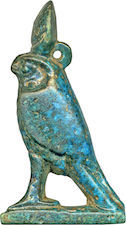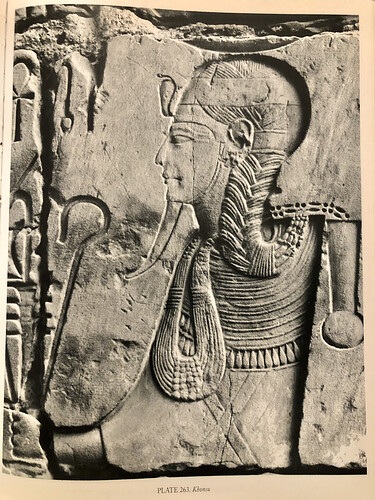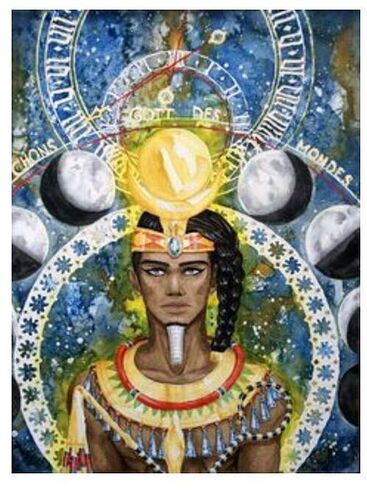Khonsu - The Lunar God of Time
‘Traveller’; ‘Embracer’; ‘Pathfinder’; ‘Defender’; ‘Healer’
It is said;
when Khonsu causes the crescent moon to shine;
women conceive, cattle become fertile…
and all nostrils and every throat;
fills with fresh air.
꧁ The God of Light in the Night ꧂
In the triad of Thebes, Khonsu be the son of Amun and Mut, the throned prime-creating power couple. With Amun being the idealizer and Mut the creator of form, Khonsu be the product of their love and alchemised energy. Khonsu is primarily known for being the god of the moon, as well as the god of time, with the abilities to influence the fertility of the people and the livestock. On the walls of Temple of Khonsu in Karnak, he’s even referred with a most-prominent role in the creation of the universe. As Luxor was seen as the temple of crowning royalty and the royal pharaonic teachings, Karnak was the seat for the synthesis, a synthesis embedded in the name of the crossing Khonsu.
In the New Kingdom, Khonsu rose to great prominence, being described as the “Greatest God of the Great Gods”. During the Ramesside period, most of the temple complex at Karnak’s construction was centered on Khonsu.
Within these great god-hooded epithets, he was known for his healing powers. Khonsu, known as a powerful god of healing, being royally invoked in desperate moments, when healing seemed out of reach. With stele-records on the healing of Princess Bekheten, simply by the display of his statuary image. He is also referenced as the healer of Pharaoh Ptolemy IV, who would come to take the epithet ‘Beloved of Khonsu who Protects the King and Drives Away Evil Spirits’. Khonsu’s protective powers, would too extend to the people living outside of the royal temples, which would lead to many Egyptians being named after him.
꧁ The Bentresh Stela ꧂
Summary
Top left: a priest offers incense to a barque carrying a form of Khonsu known as Khonsu-Spellcaster-of-Thebes-and-Chaser-of-Demons.
Top right: Ramses II, presents incense to a bargue carrying a form of Khonsu known as “Khonsu-in-Thebes-Neferhotep.” Inscription beneath tells the story of Ramses II and the Bakhtan princess.Karnak, Egypt, 21st Dynasty. Paris, Musee de Louvre, C 284.
"His Majesty then reported to Khons-in-Thebes-Neferhotep, saying: ‘Good Lord, I report to you concerning the daughter of the prince of Bakhtan.’
Then Khons-in-Thebes-Neferhotep proceeded to Khons-the-Provider, the great god who expels disease demons.
Then His Majesty said to Khons-in-Thebes-Neferhotep: ‘Good Lord, will you turn your face to Khons-the-Provider, the great god who expels disease demons, making him go to Bakhtan?’
A very strongly approving nod. Then His Majesty said: ‘Give your magical protection to him, and I will let His Majesty go to Bakhtan to save the daughter of the prince of Bakhtan.’
A very strongly approving nod of the head from Khons-in-Thebes-Neferhotep. Then he created magical protection for Khons-the-Provider-in-Thebes four times."
– Except from the Mark-Jan Nederhof translation (2006.)
꧁ The Story of Khonsu and Princess of Bekheten ꧂
Summary
"Although it was Rameses III who built the Great Temple for Khonsu in Thebes it seems that this legend was recorded some time after.
Pharaoh was in the country of Nehern (thought to be in Western Syria near the Euphrates river), collecting his annual tribute, when the Prince of Bekhten came with the other chiefs to salute him and to present gifts. The other chiefs brought gold, lapis-lazuli, turquoise, and precious woods, but the Prince of Bekhten also offered his eldest daughter (who was very beautiful) as a wife. Pharaoh accepted, and took her back to Egypt, where he made her the chief royal wife and named her Ra-neferu (“the beauties of Ra”).
Some time later, during the fifteenth regnal year, the Prince of Bekhten visited Thebes and presented offerings to the king and paid homage to him. He explained that Queen Ra-neferu’s younger sister Bent-Reshet (or Bent-enth-reshet) was very ill and he implored Pharaoh to send one of his physicians. The king immediately summoned all of the learned men of his court and asked them to choose a skilled physician to travel to Bekhten and heal the Queen”s young sister. They chose the royal scribe Tehuti-em-beb and he set off to see the poor girl. When he examined her he realised that her illness was the work of an evil spirit, which could not exorcise. So the Prince of Bekhten asked Pharaoh to send a God to combat the spirit.
The envoy arrived in Egypt during the festival of Amun. When the Pharaoh heard the message he went straight to the temple of Khonsu Nefer-hetep, and said to the god,
“My fair Lord, I have come once again into thy presence to petition you on behalf of the daughter of the Prince of Bekhten.”
The God imbued a statue of him with power and this image was sent to Beketen. After a journey of seventeen months. The god confronted the demon, who left the girl immediately, and she was cured. Then the demon spoke to Khonsu, recognising his power and asking for forgiveness. However, he also asked that a feast be held for himself and Khonsu before he left the mortal world for his own lands. A great fest was held and everyone had a great time, then the demon went home as promised.
The Prince realised how powerful Khonsu was and decided to keep his image in Bekhten. But after three years, Khonsu decided to return to Egypt in the form of a golden hawk. When the Prince saw this he felt ashamed for trying to keep the god there, and sent back all of the belongings of the god together with numerous offerings and gifts. When the tribute arrived in Egypt the pharaoh placed it at the foot of the statue of Khonsu in the Great Temple.
Adapted from “The Gods of the Egyptians” E.A. Wallis Budge


In early times of Khonsu, he was considered to be a violent and dangerous god, appearing in ‘The Cannibal Hymn’ of the Pyramid Texts as a blood-thirrsty neteru, who helps the deceased king to catch and eat the other gods. ‘The Coffin Texts’ describes him as “Khonsu who lives on hearts” and “Khonsu, drinker of blood”. With the development of his dominion of time along with his rising ties of prominence with Amun and Mut, Khonsu would transform into being considered as gentle and compassionate,
The blood-dripping Cannibal Texts, in reference to Khonsu, can be explained in the view of the royal temple’s initiations, that the king must ‘eat all of the gods to become them by heart’, giving perspective on the symbolic language, and the metaphorical meanings behind his devouring thirst, coupled with a most-honored display and perception.
The devouring aspects of Khonsu being praised, can be related to the devouring aspects of Ammit, eating the “weight-down heart” on the scales of Ma’at. In the egyptian teachings, of most significance for the royal temple-initiations, only the ket (physical body) could die as the ka (energetic body, “the inverted double”) is of immortal and timeless essence. In short; to die is to come alive, as nothing dies but transforms, a foundational basis that explains the death and rebirth of Osiris, as one example out of many.
His name has been referred to with many meanings, such as ‘the royal placenta’, but most commonly; ‘to cross’ or ‘to travel’. The crossing of the royal insignia, is a symbol often coupled with the statuary and hieroglyphic imagery of Khonsu; the synthesizing crossing of the crook and flail over his chest. His name could also be connected to his references to his travels as the Moon across the sky. He also wore the epithet ‘Khonsu nefer hotep’, meaning ‘lord of Ma’at’, a title shared with Ptah.
*‘To cross’, scribes as an ‘x’, is one of the most used symbols and vital functions in Ancient Egypt’s reflections of creation, symbolizing the very prominent function of synthesis and alchemy.
Khonsu, being and reflecting all the phases of the moon, and therefore time, took many forms. During events of new moon, he was known as the “mighty bull”, while being associated with a neutered bull during the full moon. Khonsu not only ruled the month, but was also supposed to possess absolute power over all the evil spirits that infested earth, air, sea, and sky. These spirits, hostile to the humans by attacking the body under the forms of pains, sickness, and diseases; producing decay, madness and death, held no power against the exorcising, dispelling presence of Khonsu. He it was, moreover, who made plants to grow, fruit to ripen, animals to conceive, and to men and women alike, he was the god of love.
As “Khensu-pa-khart” he was the personification of the light of the crescent moon. He was also thought to help women conceive children and help the livestock to breed successfully. This aspect of the god also has an association with fresh air, and hence the god of air; Shu.
“Khonsu pa-khered” (“Khonsu the Child”) was described as the “first great son of Amun and an aspect of the god Ra. Like Ra-Horakhty, he was thought to be a child in the morning, growing into an old man by the evening. He was also characterized with youth at the beginning of the year, who cometh as a child after he had become infirm, and who reneweth his births like ‘the disk’, being the sun.
Thus Khensu-pa-khart was both the spring sun, and the spring moon, and also the moon at the beginning of each month. He was the symbol of the renewed light of the sun and moon, and the source of generation and reproduction. In these aspects he could be linked to Horus, Ra and Min. He was also known as “Khonsu pa-ir-sekher” (“Khonsu the provider” (Chespisichis to the Greeks) and “Khonsu heseb-ahau” (“Khonsu, decider of the life span”).
The Great Temple of Khonsu was built in the precinct of the temple of Karnak. It was begun by Ramesses III, in the New Kingdom, but expanded by a number of proceeding rulers. There were three shrines dedicated to specific aspects of the god; “The Temple of Khensu”, “The Temple of Kenshu in Thebes, Nefer-hetep” and “The Temple of Khensu, who works his plans in Thebes”. Other forms of the god were probably worshipped in the main portion of the temple as aspects of the moon god.
It is referenced, how different forms and aspects Khonsu could converse with each other. For example, the mentioned Bentresh Stela (created in the 4th century BC but claiming to record a statement of Ramesses II) describes how Khonsu approaches Khonsu pa-ir-sekher, a manifestation of himself in order to free a foreign princess from a hostile spirit.
Khonsu was also associated with a number of other gods. In Khumnu (Hermopolis) he was called “Khonsu-Djehuti” associating him with Thoth. While in Thebes, Khonsu was associated with Ra, Shu, Min and Horus. During the later period Osiris and Khonsu were known as ‘the two bulls’ and represented the sun and the moon respectively.
Although firmly associated with Amun and Mut at Thebes, at Kom-Ombo in Aswan, Khonsu was considered to be the son of Sobek and Hathor (again linking him to Horus, too depicted as their son in this unifying complex). In Edfu he was considered to be the son of Osiris and known as “the son of the leg” (the leg being the part of the dead king’s body which was thought to have been found in this nome).
Khonsu, in Kom-Ombo, Aswan depicted as being the son of Hathor and Sobek
Khonsu was usually depicted as a young mummiform man in the posture of a mummy. In his role as the young son of Amun he generally wears the sidelock of youth and the curved beard of the gods. He often wears a full lunar disc resting in a crescent moon as a headdress and carries a crook and flail in his hands (the crossing of the royal insignia, linking him with the pharaoh and Osiris). His association to Osiris was further extended with the resembling chthonic wrapping around his legs and too the crossing symbol on his upper body. Occasionally, he bears a staff topped by the Was (representing power) or the djed (representing stability, ‘the spine of Osiris’). He generally wears a loose necklace with a crescent-shaped pectoral and a counterpoise in the shape of an inverted key-hole. In his mummiform aspect he looks so similar to Ptah that the only way to tell them apart is to check his necklace, as the counterpoise worn by Ptah is a different shape.
Khonsu could also be depicted as a falcon-headed man, but unlike Horus or Ra, his headdress is primarily topped by a lunar symbol. (in contrast to their solar). Though sometimes, Khonsu wore the solar disk, so too the double-plume of Osiris, Min and Amun. Like Thoth, he was associated with the baboon, but was only rarely depicted in this form.
Falcon-headed Khonsu at Karnak, wearing the double-plume and the solar disk-uraeus.
During the later period he may be depicted on plaques as fully human or in his falcon-headed form, together with his parents Amun and Mut. He may also be depicted standing on the back of a crocodile, like Horus. As “Khensu, the chronographer” he wears the solar disk on his head and holds a stylus in his right hand. Khonsu was also a great lover of games, especially senet. He was also frequently recorded playing a game of senet against Thoth. In the legends of this game, Khonsu wagered in time, while Thoth wagered in his secret wisdom, sharing their abilities in their equaling accomplishments.
꧁ Khonsu: Values and Functions ꧂
- Cleanse and exorcism of evil spirits, negative thought-forms and blockages of all sorts.
- ‘Devour to become the gods by heart’, applicable as integration of morphic fields into ones being, by heart: a torus-weaved integration.
- Fertilization; personal as environmental
- Rejuvenation; personal as environmental
- Environmental replenishing; healing rains
- Healing of time & space: mastery of past, present & future timelines in timelessness’ timeliness
- Mastery of space and form; interactive bi-locating in quantum;
Khonsu took many forms for different purposes, and possessed the ability to interact in between his form for the benefits of a mutual interest.- Master of synthesis; as embedded in the name of Khonsu, master the alchemising crossing of two to be one in its synthesized form
- Master the subconscious and emotional attributes, among all other associations with the Moon and its ebbs and flows
- Astral travels; as ‘the traveler’ and ‘traverser across the sky’, knowing all of time’s phases and existences; Khonsu guides through all the vast layers in time and space, accompanying with his protective presence
- Remote viewving, in the name of Khonsu’s own self-describing name, being Elusive and Like a Phantom, existing in places beyond one’s physical presence.
- A portal to the Temple of Khonsu, Karnak; a meditative seat to connect with Khonsu
- A connection to the symbols and insignia of Khonsu, depicted and portrayed in his scripted, statuary examples and many forms.
꧁ Khonsu: Energy Channel ꧂
- Comes with lightness and total relaxation
- Helps you look at yourself from the inside out, as if looking at yourself from the outside in
- Responsible for spiritual development and achieving goals through inner work on oneself
- Helps to recognize, accept and transform one’s fears
- Heals the body, healing channels
- Works with the heart center
- Opens doors to the subconscious mind and helps you develop therein, which in turn affects all of life.
꧁ Khonsu: Epithets ꧂
Summary
Embracer
Pathfinder
Traveller
Defender
Greatest God of the Great Gods
The Royal Placenta
Khonsu, Decider of the Lifespan
The One Who Lives On Hearts
Traverser Across The Sky
He Who Traverses Egypt In Order To Rule The Two Halves In His Great Name
Pendulum of Heaven
Divider of Months
Khonsu, Heart of Ra, Who Knows All Things
The Lion Great In Strength
He Who Makes Slaughter Of The Foes of the Wadjet Eye
Khonsu the Child
Khonsu the Provider
Khonsu Spellcaster of Thebes (and Chaser of Demons)
Khonsu in Thebes(-Neferhotep)
꧁ Hymn to Khonsu ꧂
Summary
Hail unto thee, O Messenger of the Gods!
Khonsu, the traveler of the night sky,
Who traveleth through the heaven like Thoth.
Mut-Bast is thy mother
And Amen-Ra-Temu-Kephra is thy father,
Thou makest women fruitful,
And makest the human germ to grow
in thy mothers womb.Thou art the Moon, the light -bearer,
The moon by night, and the lord of Ma’at.Thou art great and mighty oh Moon God,
Khonsu, messenger of the Great Gods,
Traveler of the night sky in the form of the Moon.Thou art a child in the morning, an old man in the evening,
a youth in the beginning of the year
who cometh as a child after he becometh infirm,
who reneweth his births like the disk.Thou art the Great God, the Lord of Heaven,
Lord of Gods, Khonsu-Nefer-Hetep-Tehuti,
Lord of Annu, Lord of rest, Chief Mabi,
Peace, peace, O Gracious One,
Who art peace, and who love peace.Thou art the Great God, Khonsu,
the Mighty, who cometh forth from Nut.Thou art the sun at sunrise and the moon.
Thou art Khonsu the chronographer,
who holdest the stylus in thy right hand.Thou art Khonsu-Nefer-Hetep
who hast absolute power over all evil spirits
which infest the earth, air, sea, and sky.Protect us from pain, sickness, and disease. Protect us from decay, madness, and death.
We invoke thee.
Show us thy Wisdom.
Thou makest the plants to grow and the fruit to ripen,
and animals to conceive.Thou whom the Gods adore.
Thou art the God of love whom men and women adore.
Thou art Healer and Powerful in Magic!
Protect us!Accept our offerings, O Great Moon-God Khonsu,
who lives forever.




















